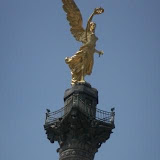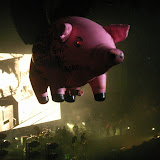This is the site of the Sun and the Moon pyramids, and was Mexico's biggest ancient city and capital of the largest pre-hispanic empire. The city was developed in the early part of the first century AD, and the pyramid of the Sun was built by 150AD. At 2300m above sea level, it was always going to be a challenge to climb , but we all did it! Daniel then climbed to the top of the Pyramid of the Moon - twice - because on the first climb there was no one at the top that he knew to take his photo, so he came down and went back up!
The Avenue of the Dead was the main street of Teotihuacan. It ran for more than 2.5 km, beginning at the Moon Plaza to the north and extending beyond the Ciudadela and the Great Compound complexes to the south.
The avenue divided the city into two sections. Apartment compounds with pyramidal constructions were arranged on both sides of the avenue, often symetrically and sharing the same orientation. This highly planned city-layout suggests that the avenue may have been planned since its earliest phases of urbanization.
The main sector of the avenue was evidently the section between the Moon Pyramid and the Rio San Juan channel. This part of the avenue was lined with long platforms. Access to flanking residential zones was confined to masonry stairways with balustrades. The width of the avenue varies significantly between different sections, ranging from 40 to 95 metres. A large long channel under the floor of the avenue gathered rain water from neighboring architectural units and drained it into Rio San Juan.
As originally built, the Sun Pyramid was approximately 215 by 215 m at the base, and about 63 m high. It was significantly enlarged at least twice in later periods, resulting in a final size of 225 m along each side. The pyramid was located on the east side of the Avenue of the Dead in the northern half of the city. If the area of monumental construction between the Moon Pyramid and the San Juan Canal is regarded as the central zone of the city, the Sun Pyramid is located at its middle. In addition to its geographic centrality, the importance of the pyramid is indicated by a cave located under the structure, which was used for ritual purposes.
The Moon Pyramid is located at the northern end of the Avenue of the Dead, which was the main axis of the city. The pyramid, facing south, was built as the principal monument of the Moon Pyramid complex. The five-tiered platform was attached to the front of the Moon Pyramid. It is said that the present pyramid has interior structures within it.
The consolidated structures around the Moon Plaza demonstrate that the city was highly planned symmetrically and was integrated into the local geography. This may be realized by standing on the center line of the Avenue of the Dead, namely on the main axis of the city. The top of mountain Cerro Gordo dominating the background of the Moon Pyramid exactly coincides at a certain point of the avenue with the top of the pyramid; a pan-Mesoamerican notion that the pyramid represents a sacred mountain seems to have been an integral element of the city plan. The Avenue of the Dead begins at the Moon Plaza, which was surrounded by 15 pyramidal structures including the Moon Pyramid. The Quetzalpapalotl Palace lies immediately to the southwest of the Moon Plaza. Like the Main Plaza in the Ciudadela, the Moon Plaza seem to have been one of the main ritual precincts of the city.



